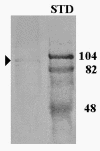Fas induces apoptosis in human coronary artery endothelial cells in vitro
- PMID: 14738570
- PMCID: PMC331398
- DOI: 10.1186/1471-2121-5-6
Fas induces apoptosis in human coronary artery endothelial cells in vitro
Abstract
Background: Published work suggests that some types of endothelial cells undergo apoptosis in response to ligation of the receptor Fas (CD95, APO1) but other types are resistant. Because heterogeneity among endothelial cells from different tissues, has been demonstrated, the purpose of this study was to determine, if Fas ligation and/or activation by human Fas ligand induces apoptosis and caspase activities, in cultured human coronary artery endothelial cells, and the differences between TNF-a and FAS induced apoptosis in these cells.
Results: Cultured human coronary artery endothelial cells (HCAEC) were exposed to the monoclonal Fas-activating antibody CH-11, to purified recombinant human Fas ligand, to the Fas-neutralizing antibody ZB4, or to purified recombinant human TNF-alpha. Apoptosis was detected by assessment of chromatin condensation and nuclear fragmentation and by assay of the enzymatic activities of Caspase 1 and Caspase 3 with membrane-permeable substrates applied to intact cells. Fas protein was detected by immunoblotting of HCAEC lysates. Apoptosis was induced in HCAEC by purified Fas ligand or by the monoclonal activating antibody CH-11 at concentrations of 25 or 200 ng/ml, but not by nonspecific isotype-matched immunoglobulins. The apoptotic index elicited by either Fas activator was equal to that induced by TNF-a (3.0-3.6-fold versus control, p < 0.01). The Fas-neutralizing antibody ZB4 abrogated HCAEC apoptosis induced by CH-11, but had no inhibitory effect on apoptosis in response to TNF-a. Fas ligation significantly increased the activities of both Caspase 1 and Caspase 3 at 20 hours of stimulation (1.7- and 2.0-fold versus control, both p < 0.05); in contrast, purified TNF-a increased the activity of Caspase 3 but not Caspase 1 (2.1-fold, p < 0.05). Western blotting of HCAEC lysates with antibody CH-11 identified a single immunoreactive protein of 90 kDa.
Conclusions: Cultured human coronary artery endothelial cells express functional Fas capable of inducing apoptosis in response to either purified Fas ligand or receptor-activating monoclonal antibodies, at levels equal to those inducible by purified TNF-alpha. Immunologic studies and differential kinetics of caspase activation suggest that Fas and TNF-alpha induce apoptosis in HCAEC by signaling pathways that are distinct but equal in potency.
Figures







Similar articles
-
Endothelium down-regulates Fas, TNF, and TRAIL-induced neutrophil apoptosis.Surg Infect (Larchmt). 2002 Winter;3(4):351-7. doi: 10.1089/109629602762539562. Surg Infect (Larchmt). 2002. PMID: 12697081
-
The monoclonal antibody 225 activates caspase-8 and induces apoptosis through a tumor necrosis factor receptor family-independent pathway.Oncogene. 2001 Jun 21;20(28):3726-34. doi: 10.1038/sj.onc.1204490. Oncogene. 2001. PMID: 11439335
-
Thyroid carcinoma cells are resistant to FAS-mediated apoptosis but sensitive to tumor necrosis factor-related apoptosis-inducing ligand.Cancer Res. 2000 Aug 1;60(15):4122-9. Cancer Res. 2000. PMID: 10945619
-
Negative regulation of inflammation by Fas ligand expression on the vascular endothelium.Trends Cardiovasc Med. 1999 Jan-Feb;9(1-2):34-41. doi: 10.1016/s1050-1738(99)00006-7. Trends Cardiovasc Med. 1999. PMID: 10189965 Review.
-
Is extravasation a Fas-regulated process?Mol Med Today. 1999 Feb;5(2):61-7. doi: 10.1016/s1357-4310(98)01415-4. Mol Med Today. 1999. PMID: 10200946 Review.
Cited by
-
Understanding endothelial cell apoptosis: what can the transcriptome, glycome and proteome reveal?Philos Trans R Soc Lond B Biol Sci. 2007 Aug 29;362(1484):1469-87. doi: 10.1098/rstb.2007.2129. Philos Trans R Soc Lond B Biol Sci. 2007. PMID: 17569639 Free PMC article. Review.
-
Recombinant human erythropoietin suppresses endothelial cell apoptosis and reduces the ratio of Bax to Bcl-2 proteins in the aortas of apolipoprotein E-deficient mice.J Cardiovasc Pharmacol. 2011 Apr;57(4):424-33. doi: 10.1097/FJC.0b013e31820d92fd. J Cardiovasc Pharmacol. 2011. PMID: 21242808 Free PMC article.
-
Soluble Fas ligand inhibits angiogenesis in rheumatoid arthritis.Arthritis Res Ther. 2007;9(2):R42. doi: 10.1186/ar2181. Arthritis Res Ther. 2007. PMID: 17459170 Free PMC article.
-
Infection with Porphyromonas gingivalis exacerbates endothelial injury in obese mice.PLoS One. 2014 Oct 21;9(10):e110519. doi: 10.1371/journal.pone.0110519. eCollection 2014. PLoS One. 2014. PMID: 25334003 Free PMC article.
-
Cryptosporidium parvum induces B7-H1 expression in cholangiocytes by down-regulating microRNA-513.J Infect Dis. 2010 Jan 1;201(1):160-9. doi: 10.1086/648589. J Infect Dis. 2010. PMID: 19916867 Free PMC article.
References
Publication types
MeSH terms
Substances
Grants and funding
LinkOut - more resources
Full Text Sources
Research Materials
Miscellaneous

